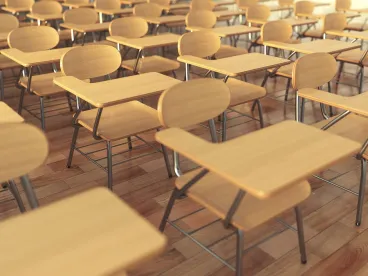Ohio’s FY 22-23 Operating Budget: Overall Policy Implications for K-12 Schools
The following document provides an overview of changes to law affecting Ohio’s K-12 schools which are contained in Substitute House Bill 110 (“HB 110”), the State of Ohio’s Operating Budget for Fiscal Years 2022 and 2023. Ohio’s Operating Budget not only appropriates funds for essential government services, it also contains hundreds of policy changes.
HB 110, as signed by Governor DeWine on June 30, 2021, contains a historic restructuring of the State of Ohio’s school funding method. The passage of the Fair School Funding Plan (which creates a more equitable, stable, and predictable revenue stream for Ohio schools) is, “a culmination of decades,” as House Speaker Bob Cupp (R-Lima) said last week.
HB 110 will also change the burden schools have to transport students, sell district-owned properties to charter and STEM schools, inform parents about sex education curricula, and more. It will also provide districts with the opportunity to administer online learning options and students with the opportunity to opt-out of the ACT and SAT.
Information about the impact that the Operating Budget will have on Ohio’s institutions of primary and secondary education can be found below. Please do not hesitate to contact any of the listed professionals with questions.
SCHOOL FUNDING PROVISIONS
The design of a funding mechanism for Ohio’s K-12 schools was perhaps the greatest difference between the multi-billion dollar Operating Budgets initially proposed by the House and Senate, and the highest-profile disagreement.
In the final budget, the chambers agreed to adopt the House’s Fair School Funding Plan, an overhaul of Ohio’s education funding system, nearly in its entirety. This was a major victory for House Speaker Bob Cupp, who began the Fair School Funding Plan workgroup with now-retired Rep. John Patterson (D-Jefferson) in 2017.
Both local incomes and property values will now determine the financial burden a district should be able to cover on its own, with the remainder (the “state share,”) growing to meet the difference. Per-pupil base cost will be based on local costs instead of a single, statewide average.
Senate President Matt Huffman (R-Lima), whose passion for education policy matches Cupp’s, won victories for a cause close to his heart: school choice, and school vouchers. President Huffman’s Senate plan featured an increase in amounts for all of the state’s tax-funded scholarship programs, including EdChoice scholarships, as well as smaller state scholarship programs benefitting students with special needs. This provision remains in the final compromise.
A major feature of the Fair School Funding Plan, which persisted throughout the budget compromise process, is the direct funding of these scholarships. Under current law, schools remit payments for vouchers in a process known as the district-deduct model. When this budget goes into effect, the State will assume the financial burden for vouchers and directly fund them.
Scholarship amounts will also increase. For instance, EdChoice, which has the highest enrollment and chiefly benefits students in districts with the lowest state test scores, will now award qualifying K-8 students $5,500 per year and high school students $7,500 per year for tuition at non-public schools.
Additional Education Funding Formula Details - HB 110:
-
Specifies that the funding mechanism is authorized only for Fiscal Years 2022-2023.
-
Maintains direct funding for private school vouchers and charter schools.
-
Creates a direct funding model for open enrollment.
-
Includes funds for Student Wellness and Success funding (inside the formula).
-
Allocates $50 million to the School Bus Purchase Fund.
NON-MONETARY POLICY PROVISIONS
Transportation
School Districts must to report to the State Board of Education:
-
Actual costs associated with transporting eligible students with disabilities for whom transport by regular bus is not possible;1
-
The age, mileage and overall physical condition of district-owned vehicles.
HB 110 also changes how districts will be paid when transporting all other students including those attending STEM, community or non-public schools by providing for efficiency adjustments. Districts may want to change their transportation routes to take advantage of efficiency incentives. The Budget appropriates funding for transportation collaboration grants to districts whose efforts lead to shared resource management or regional collaboration.
Districts are prohibited from providing transportation via a mass transit system to the community or chartered non-public students in grades K-8 (unless agreed to by the alternative school).
The Budget places restrictions on the use of mass transit for students grades 9-12 as well, requiring a district opting to utilize mass transit to transport those students to:
-
Establish a contract with the transit system specifying each student is transported on a vehicle and route designed for fare-paying passengers and students, and to
-
Verify that no student has more than one transfer.
The bill makes changes to payment in lieu of transportation provisions, including allowing the non-public or community school to act on behalf of the parents when the parents have chosen to allow them to do so. This means private and charter schools can speak on behalf of parents who provide them with their proxy in negotiations with public schools regarding transportation.
The bill also extends deadlines for community schools to notify public districts, in writing, of their intent to assume responsibility for the transportation of district students. The current requirement is January 1 of the prior school year. The new deadline is August 1 before the school year.
Unused School Facilities
The Budget changes the conditions which require a district to offer buildings for lease or sale to community or STEM schools. When this provision is effective, the definition of “unused school facilities” will be:
(a) Any real property used for school operations, including, but not limited to, academic instruction or administration, since July 1, 1998, which has not been used in that capacity for one year (existing law), OR
(b) Any school building that has been used for direct academic instruction but less than sixty percent of the building was used for that purpose in the preceding school year (added by HB 110)
Academic Distress Commissions
HB 110 prohibits the establishment of new academic distress commissions for the 2021-2022 and 2022-2023 school years. Previously, continuing law had required the establishment of an academic distress commission for any district which received an overall grade of “F” on the state report card for three consecutive years.2
For the three school districts currently governed by academic distress commissions, the bill provides a pathway out of state control. Sub HB 110 requires each district to submit a three-year academic improvement plan to the State Superintendent within 90 days of passage, and ultimately to begin implementing a plan starting July 1, 2022. It is perhaps notable that State Superintendent Paolo DeMaria will not be the individual who reviews these plans, as he announced his pending retirement soon after the Governor signed the Budget.
During the implementation of the district-made improvement plan, the community-elected Board of Education in each district will resume power, including power to choose a district superintendent. Beginning July 1, 2022, the school boards governing Lorain City Schools, East Cleveland City Schools, and the Youngstown City School District will resume power. This agreement between the House, Senate, and Governor comes after a years-long battle to address the ineffectiveness of state takeovers.
EdChoice & Cleveland Scholarships
HB 110 expands eligibility for EdChoice scholarships by automatically granting scholarships to siblings of students who had a scholarship the previous year. Scholarships are also automatically granted to children placed in foster care, including those who are living with a guardian, legal custodian or kinship caregiver in an arrangement administered by the state.HB 110 also lifts the existing cap on the number of EdChoice Scholarships.
The bill also allows K-8 students who have a Cleveland Scholarship to attend a chartered non-public school outside of the district lines (this is similar to current law applying to high school students).
Online Learning
School districts, with permission of the State Superintendent, may operate a school using an online learning model. To do so, districts will be required to assign all students learning online to a single school. Additional requirements for online learning:
-
Ensure each student has a device and internet access;
-
Provide a comprehensive orientation for the student and the parent related to online learning policies;
-
Enlist a time-tracking learning management system.
The bill also requires the State Board of Education to revise operating standards for online learning, so additional requirements may follow.
Charter Schools
The Budget allows community schools to start in any school district (rather than only challenged districts as under current law) and prevents any automatic closure of a community school based on report card ratings from the 2022-2023 school year.
Employee Training, Employment Requirements, and Recordkeeping
Allows an individual with a two-year initial career-technical workforce development license or a five-year advanced career-technical workforce development license to have a certificate of high school equivalence rather than requiring that they have a high school diploma.
The law on pre-employment applications and screening was changed to require a written notice on the illegality of making a false statement, requiring checks of ODE’s “educator profile”, permitting districts to offer conditional employment pending completion of screening processes and allowing districts to require employees and volunteers to undergo additional background checks.
Additionally, districts will be required to establish a protocol regarding the district’s response to requests from other schools for the transmission of employee personnel files. They must also establish a process to review the personnel files of employees against whom a misconduct complaint has been filed. When considering an applicant for a position within their school district, Boards of Education will have the right to request any report of misconduct which ODE received for that individual.
The bill requires that the Educator Standards Board incorporate knowledge of the CTAG program into standards for school counselors. Also, it continues to allow individuals to teach computer science courses even if they are not licensed in that subject.
Under provisions related to the Autism Scholarship, the bill now allows certified Ohio Behavior analysts and registered behavior technicians to provide intervention services.
Testing and Curricular Requirements
Parents will have the right to opt their student out of the requirement that they take a nationally standardized college admission test starting with the class of 2026. It also adjusts the time frame for districts administering the kindergarten readiness assessment and the kindergarten reading skills assessment. The following changes were made to curriculum requirements:
-
Sex Education;
-
Districts are required to notify and seek permission from parents/guardians if students will receive instruction on the topics of venereal disease and sexual education beyond those specified under current law.
-
Notification must include the names of the instructor, vendor, and curriculum.
-
Instructional materials must be provided to parents upon request.
-
Districts are required to report annually to ODE on advanced standing programs.
-
-
Vaping: Districts are required to instruct students in health classes about the effects of vaping
-
Computer science: Districts must offer students the opportunity to take a computer science course approved by ODE.
Miscellaneous Additional Provisions
-
Repeals the requirement that school districts, interscholastic conferences and organizations that regulate athletics have uniform transfer rules for public and non-public schools.
-
Amends requirements for alternative graduation pathways.
-
Amends graduation requirements for chartered non-public schools and students transferring into public and chartered non-public schools.
-
Specifies that chartered non-public schools may elect to receive auxiliary service funds directly from the state, rather than from their local school district.
-
Amends STEM school proposal requirements and lifts some of the requirements under which current STEM schools operate.
-
Mandates that schools and districts selected to participate in the National Assessment of Education Progress do so.
-
Establishes new procedures for youth who have been assigned to a residential treatment center to enroll in approved programs and the procedure for how districts will have to pay those programs.
-
Makes Several earmarks within state line items in support of specific programming (including several provisions regarding federal pandemic relief funds).
1 These costs will be subject to random audits by ODE. ODE will also monitor compliance with other transportation policy requirements.
2 RC 3302.10(A)(1)




 />i
/>i

